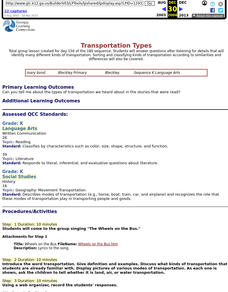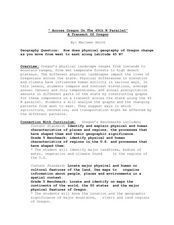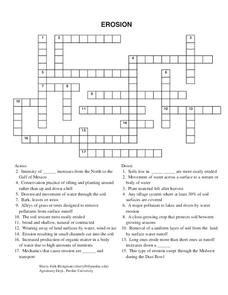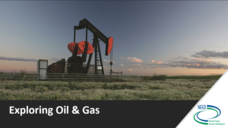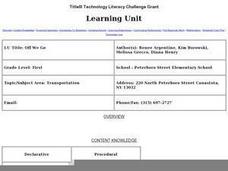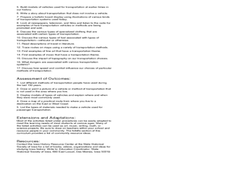Curated OER
Transportation Types
Students answer questions after listening for details that identify many different kinds of transportation.
Curated OER
Carve That Mountain
Students investigate major landforms (e.g., mountains, rivers, plains, hills, oceans and plateaus). They build a three-dimensional model of a landscape depicting several of these landforms. Once they have built their model, they act as...
Curated OER
"Across Oregon On The 45th N Parallel" A Transect of Oregon
Students explore the physical geography of Oregon. In groups, students collect weather and elevation information on Oregon. They organize the data and create maps and graphs of the information. Afterward, students compare the...
Curated OER
Erosion
In this erosion worksheet, students complete a crossword puzzle given 17 clues about the types of erosion, the causes of erosion and the results of erosion.
National Energy Education Development Project
Exploring Oil and Gas
The United States consumes more oil than any other country, about 1.85 billion barrels (or 77 billion gallons) a day. Viewers learn about the history of fossil fuel exploration and how they are formed in an informative presentation. They...
Curated OER
How Did That Get There?
Students evaluate the role of government in addressing land use and other environmental issues. They analyze the powers, responsibilities, and limitations of elected and appointed officials in the national legislative, executive, and...
Curated OER
Off We Go
First graders identify different types of transportation, and explain why each is important. They pretend they are going on a trip. They choose their mode of transportation, and use play money to buy their tickets.
Curated OER
Getting from Place to Place
Students examine modes of transportation. In this transportation instructional activity, students listen to their instructor present a lecture on modes of transportation over the past 300 years. Students respond to questions about the...
Curated OER
How Will We Get There?
Students discuss and make a T chart of how to travel in Hawaii and understand that it is a group of islands that you cannot drive to. For this Hawaii lesson plan, students also discuss the kinds of transportation we use on the main land.
Curated OER
Development Issues in the Northern Suburbs
Students demonstrate the ability to obtain geographic information from a variety of print and electronic sources. They use a variety of maps and data to identify and locate geographical features of Minnesota and Anoka County. in...
Curated OER
Landforms of Illinois
Young scholars discover the primary landforms of Illinois. They examine how those landforms were formed as well. In groups, they research one of the landforms from their vocabulary list. They create their landform in a shoebox and...
Curated OER
Traveling to Texas
First graders read "Where the River Begins" by Thomas Locker and discuss the Texan landscape. They use construction paper to make suitcases and then fill them with types of Texan landforms and scenery they might see on a trip to Texas.
Curated OER
Erosion
In this earth science worksheet, learners describe the course of the river from its source to the mouth, including shapes of the valleys and erosion processes in each course. Then they identify possible types of erosion that would have...
Curated OER
This Mine of Mine
Students explore natural resources by conducting a geology experiment in class. In this mineral mining lesson, students discuss the types of geological material that can be found when mining and the uses for these resources such as coal....
Carnegie Mellon University
How Power Plants Work 1
First of three lessons, this is a great start to a unit on energy. As you demonstrate, learners discover different types of energy and how it is converted from one form to another. They then focus in on the generation of electricity by...
Curated OER
Mapping My Community
Ninth graders are introduced to GPS technology. They complete fieldwork as they visit a specific area of their community to identify and map types of land use in the surveyed area. They use the collected data to create a digital map.
Curated OER
Lesson L - Hit The Road Jack (or Jill)
Students discuss forms of transportation in Delaware during 18th Century, find approximate area of court order on current map of state, draw layout of their school, and decide where new hallway or outside pathway would be most needed.
Curated OER
A Bridge is for Crossing
Students examine the bridges of Washington State. They focus on the suspension bridge between Tacoma and Gig Harbor. They see how three different types of bridges work by rotating students through bridge stations.
Curated OER
Locating Echo
Students read the book The Adventure of Echo the Bat. For this animal science lesson, students read the book and create a chart labeled "Land Feature," "Habitat," and "Food." Students fill in the table according to where the character...
Curated OER
The Miracle Resource - From Forest to Products
Young scholars create a collage of wood products labeled by type of wood product. In this product engineering lesson, students work in groups to find pictures of solid wood products, engineered wood products, wood pulp, paper products,...
Curated OER
Find Yourself with Global Positioning
Students examine different types of new mapping technologies. They use the internet to gather information about mapping and navigation. They create their own global positioning tool and defend it to the class.
Curated OER
Life on Plymouth Plantation
Third graders research life of Plymouth Plantation and write letters about life there home. In this Plymouth life lesson plan, 3rd graders complete a webquest as they gather information about the journey to America on the Mayflower and...
K12 Reader
Natural Resources
What natural resources are available in your area? Your learners can consider this question after reading a brief passage about natural and renewable resources. After reading, class members respond to five questions related to the reading.
Curated OER
Exploring the Water Cycle
The water cycle is one of earth's most easily observable processes, but demonstrating each step within classroom walls can be a challenge. Through a series of videos and quick demonstrations, cover each aspect of the hydrologic cycle in...


